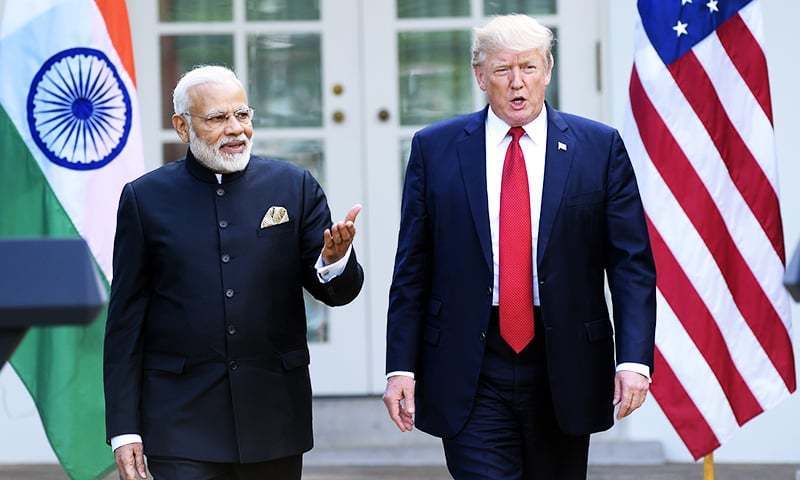IN the middle of Monday night’s fairly orthodox speech on Afghanistan, President Donald Trump swerved into a brief discussion of India. It would have been odd to summarise a “comprehensive review of all strategic options in Afghanistan and South Asia” without mentioning India, with 1.3 billion people. But the president, after studying “Afghanistan in great detail and from every conceivable angle”, used the occasion to prod India to do more to solve America’s 16-year Afghanistan problem.
Consistent with his mercantilist worldview, Trump highlighted that “India makes billions of dollars in trade with the United States”. This is true: India shipped approximately $24bn more in exports to the United States in 2016 than it imported from the US. After underlining India’s vulnerability, Trump then stressed, “We want them to help us more with Afghanistan, especially in the area of economic assistance and development.”
So what’s the story here? India has done much to help Afghanistan already, as Trump appropriately acknowledged in his address. India has provided $2bn of aid to Afghanistan, and pledged an additional $1bn more last September. It is, by far, the most generous donor among the “regional countries”.
Indian-built projects include a large hydroelectric dam and a “spur” that connects the Afghan highway network to Iran — and even the newly built Afghan parliament building. India has also trained more than 4,000 Afghan National Army officers and provided helicopters to the Afghan Air Force.
Like the United States, India does not want Afghanistan to act as a staging ground for international terrorists, many of whom would be as happy to target Indian cities as European or American ones. When US cruise missiles struck Al Qaeda-linked training camps in Afghanistan following the 1998 bombings of the US embassies in Kenya and Tanzania, several members of anti-India terrorist groups were killed in the apparently shared facilities.
India does not have the geography to alter the strategic course of landlocked country
In addition, India suffered the unique embarrassment in December 1999 of having to hand over three captured militants in Taliban-controlled Kandahar to secure the release of the passengers and crew aboard a hijacked Indian airliner.
Here’s the problem: India does not have the strategic tools — or the geography — to alter the strategic course of Afghanistan. Its $3bn aid commitment is about two per cent of total international donations to Kabul since 2002.
Pakistan, which sits between India and Afghanistan, is wary of facing adversaries on both its western and eastern borders.
US policymakers have long considered a greater Indian role, but such deliberations quickly led to brutal arithmetic: what economic aid, military training or even ground forces could India send to Afghanistan that Pakistan could not offset through support to hostile militant groups?
Despite having the world’s second-largest military, India cannot take over for the United States in Afghanistan. Since independence, India has modest experience operating expeditionary forces in hostile environments, mostly from UN peacekeeping operations but also a failed attempt to intervene in Sri Lanka in the late 1980s, what some described as “India’s Vietnam” experience. The Indian military, despite its ongoing modernisation, would still find it hard to support major operations at considerable distance.
Any large-scale Indian military effort would have to bypass Pakistan, and require support from Iran. In fact, it is difficult to imagine any enhanced Indian role — economic or military — in Afghanistan without closer Indo-Iranian ties, which would probably generate friction with Iran hawks empowered in the Trump administration.
Trump’s public invitation of more Indian involvement is likely to put more pressure on Pakistan, which already faces the prospect of cutbacks in US aid. Pakistani military leaders have a choice: acquiesce to outside pressure and lose their current veto on Afghan stability, or accept possible sanctions. The prospect of greater Indian involvement may empower hawks in Islamabad who argue Pakistan must bear whatever costs necessary to avoid strategic encirclement. Trump’s effort seems more likely to escalate Pakistan’s own involvement than compel an end to Pakistani interventionism.
If India does play a bigger role and Pakistan continues its cross-border support, it is likely to leave all the players roughly where they now sit: engaged in a holding action to prevent the territorial defeat of the Afghan state from a mostly indigenous insurgency.
India probably will contribute more aid, technical expertise and military training in Afghanistan, but there should be no illusions that those efforts will substantially ease the US mission there. At the end of the Trump administration, in all likelihood there will still be thousands of US service members in Afghanistan, many of them younger than the war in which they will be fighting.
By arrangement with The Washington Post
Published in Dawn, August 26th, 2017














































